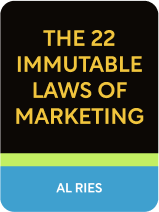

This article is an excerpt from the Shortform book guide to "The 22 Immutable Laws of Marketing" by Al Ries and Jack Trout. Shortform has the world's best summaries and analyses of books you should be reading.
Like this article? Sign up for a free trial here .
What is the Law of Singularity in marketing? Why is it better to focus your efforts on one big jab rather than multiple small punches?
The Law of Singularity states that you should focus on finding opportunities to make a bold move that makes a big impression. The Law of Candor goes further to say that that big impact may even be the act of acknowledging your own negative attributes and exploiting them.
Continue reading about the Law of Singularity and the Law of Candor from The 22 Immutable Laws of Marketing.
Be Strategic About Your Overall Marketing Plan
Aside from the details of your marketing campaign—such as your word and your primary message to consumers—be strategic with your overarching tone and approach. Use the Law of Singularity and Law of Candor to consider the big picture of your marketing plan.
The Law of Singularity
In marketing, the only way to make headway against your competitors is to focus on singular, impactful strikes. The cumulative effect of countless small efforts won’t move the needle much—instead, the Law of Singularity says to focus on finding opportunities to make a bold move that makes a big impression. Your competitor may have just one weak spot, and you should direct all of your energy toward exploiting it. Such opportunities may be few and far between, but when you find them, capitalize on them. This means that your company’s top managers need to be on the front lines, aware of what’s happening in the marketplace, and intricately involved in the marketing process so that they can be ready to seize opportunities when they arise.
At the time of this book’s publication, Coca-Cola was marketing Coca-Cola Classic as well as New Coke—and the company was struggling to keep its lead over Pepsi. Ad campaigns tried different slogans, from “We have a taste for you” to “Catch the Wave” to “You can’t beat the feeling.” The firm needed to make a bold move to regain its footing. When it came down to it, Coca-Cola’s only ammo was its strong association with the phrase the “Real Thing.” The brand hinged on being the original cola, and the authors suggest that the only way to reclaim that position was to drop New Coke and put all its effort into promoting Coca-Cola Classic as the Real Thing.
The Law of Candor
Despite all your effort to choose an attribute and connect it with your brand, you can’t help it if your competitors attach a different, negative attribute to your name. However, all is not lost: When competing brands and consumers call out something negative about your product, acknowledge it and turn it into a positive. Just as you need to acknowledge your position on the market ladder, you must acknowledge widely held beliefs about your product—especially negative ones. Whereas people are often skeptical of positive claims, when companies make negative admissions about their products, the public generally accepts them as facts.
If you try to deny the negative—especially when it’s a widely acknowledged fact—you’ll lose credibility. The challenge is to find a way to show that the negative attribute implies other positive attributes. For example, Scope mouthwash claimed “good-tasting” as an attribute because it was common knowledge that its competitor, Listerine, had an awful taste. That put Listerine in a tough position: If the company tried to deny that the product tasted bad, it would lose credibility with consumers. Instead, the firm embraced the negative with the tagline, “The taste you hate twice a day.” This implied that the product’s terrible taste must mean it’s a powerful germ killer, and it encouraged customers to use the product despite its taste because it was good for them.
This strategy has saved numerous companies from crises, but it must be used carefully. Consider these two caveats:
- The negative must be commonly known among consumers—in other words, the negative must be a given, and that allows you to build upon it. If customers aren’t already familiar with the negative, you’ll either be calling attention to it or you’ll end up confusing them.
- Once you’ve established the negative, immediately pivot to the positive. The point is not to apologize for the negative, but rather to use it as a prop for your message.

———End of Preview———
Like what you just read? Read the rest of the world's best book summary and analysis of Al Ries and Jack Trout's "The 22 Immutable Laws of Marketing" at Shortform .
Here's what you'll find in our full The 22 Immutable Laws of Marketing summary :
- Why the quality of your product matters less than customers' perceptions of it
- Why trying to appeal to everyone will sink your sales
- How Marlboro sold more cigarettes to women by marketing to cowboys






